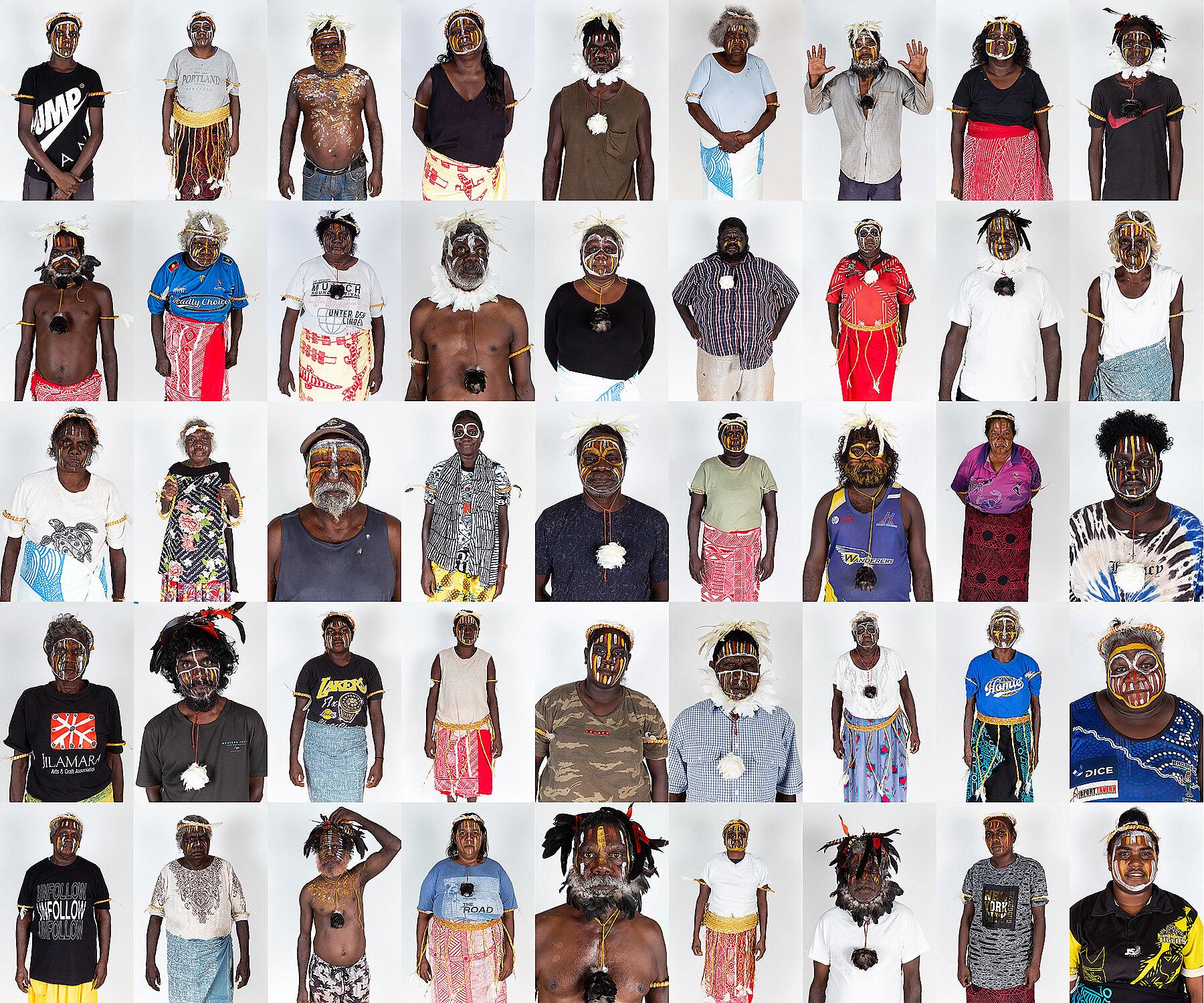

Artists Statement: “Before birds were birds, birds were human. There was pelican, the white egret, the owl, the black cockatoo and the white cockatoo. They heard Purukuparli and said, ‘We will give you feathers to make headbands, armbands, false beards.’ Then Purukuparli had the ceremony on the eastern side of Melville Island. That was a long time ago. That story was told by my ancestors, my close family.” – Pedro Wonaeamirri
Contemporary Tiwi art practice has its foundations in jilamara (design) derived from ceremonial body painting and decoration applied to the body, tunga (bark baskets) and tutini poles made for Pukumani (mourning) ceremony and Tiwi Yoi (dance). This collaborative work from artists at Jilamara Arts and Crafts on the Tiwi Islands draws on these performative foundations of the artwork made at the centre. Using photo mediums in a contemporary gallery context, this work is an expression of self-control, keeping the Tiwi culture close and controlling the creation and dissemination of related imagery, rather than being represented by outside people.
Jilamara Arts and Crafts Association is owned and governed by artists from the community of Milikapiti on the Tiwi Islands. Originally an adult education centre in the 1980s, Jilamara Arts and Crafts Association became an incorporated non-profit Tiwi governed art centre in 1989. Ever since the organisations vision has been to support the contemporary art careers of its members and keep culture strong in the small community of Milikapiti.
"From body it moved onto bark and then canvas, silk, printing and now we are moving into digital. Culture is evolving with time." - Colin Heenan-Puruntatameri, 2019
Through workshops, training and representation Jilamara members of diverse abilities are supported to build careers as internationally renowned artists. In the community, the art centre is also an important place for local school children to learn through culture classes and for many generations of Tiwi people to build bright futures.
Artists left-right: Arthurina Moreen, Barbara Puruntatameri, Chris Kojack Black, Bernadette Mungatopi, Gerard Bush, Dorianna Bush, Johnathon World Peace Bush, Joselyn Black, DK Mungatopi, Jimmy Mungatopi, Brenda Patricia Bush, Consolata Mungatopi, Ian Cook, Connie Puruntatameri, Dino Wilson, Edwina Moreen, Jason Joran, Kerry Woody, Nellie Punguatji, Kaye Brown, Kenny Brown, Kathleen Puruntatameri, Patrick Freddy Puruntatameri, Josephine Warlapinni, Reggie Mungatopi, Jacinta Lorenzo, Richard Djorlam, Raelene Kerinauia, Rodney Moreen, Kimberley Stassi, Nancy Kerinauia, Nancy’s sister, Pedro Wonaeamirri, Mary Elizabeth Moreen, Aileen Puruntatameri, Michelle Bush, Angelina Moreen, Roselyn Brown, Columbiere Tipungwuti, Mildred Lorenzo, Vincent Mungatopi, Michelle Woody Minnapinni, Timothy Cook, Serafina Stassi, Jessica Stassi
Also known as Giclee prints or bubble-jet prints, pigment ink-jet prints are generated by computer printers from digital or scanned files using dye-based or pigment-based inks. A series of nozzles spray tiny droplets of ink onto the paper surface in a precise pattern that corresponds to the digital image file. In dye-based prints the ink soaks into the paper, whereas in pigment-based prints the ink rests and dries on top of the paper surface.
Whilst the term is broad, pigment ink-jet prints have come to be associated with prints produced on fine art papers. They are the most versatile and archival method of printing available to photographers today. A wide variety of material on which an image can be printed with such inks are available, including various textures and finishes such as matte photo paper, watercolour paper, cotton canvas or pre-coated canvas.
